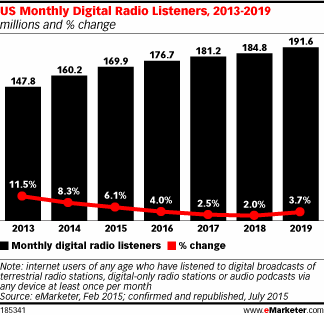 Internet radio audience has grown quickly. The industry commands somewhere between 600 – 900 million monthly listeners globally depending on which analysis you choose to cite. In the U.S., Edison Research reveals that 57% of the population listens monthly and 50% weekly. That will translate into 177 million listeners this year according to eMarketer. The growth will allow Internet radio and streaming music services to capture an increasing share of the $42 billion in mobile advertising forecasted for 2016.
Internet radio audience has grown quickly. The industry commands somewhere between 600 – 900 million monthly listeners globally depending on which analysis you choose to cite. In the U.S., Edison Research reveals that 57% of the population listens monthly and 50% weekly. That will translate into 177 million listeners this year according to eMarketer. The growth will allow Internet radio and streaming music services to capture an increasing share of the $42 billion in mobile advertising forecasted for 2016.
Data Confirm Ad-Supported Listening Dominates Internet Radio
Most Internet radio listeners choose ad supported listening. Recent analysis of IFPI and MIDiA Research data suggest that 91% of listeners globally are using ad-supported services. Strategy Analytics estimated last year the number was 89% and wouldn’t change materially over the next five years. Nielsen last year also revealed its estimate for U.S. listeners was even more skewed to ad-supported listening at 95%. This makes sense. Consumers worldwide are accustomed to hearing ad-supported radio. When they transition online, many are following habits from radio listening. Subscription models get a lot of attention, but they remain a small part of the listening audience.
Given the audience size, it is not surprising that advertisers are increasingly testing the Internet radio advertising waters. XAPP’s Internet Radio Ad Load Report 2015 found that unique advertisers grew by 5.4 times between the fourth quarters of 2014 and 2015.
The Mobile Audio Phenomenon
When advertisers do move to Internet radio and music streaming services, they are by default adopting a mobile marketing channel. There are a number of different studies on this. comScore estimates mobile consumption on streaming services is 95% with 79% on smartphones. Its research shows Internet radio as the most mobile of media and content. Only gaming is close.
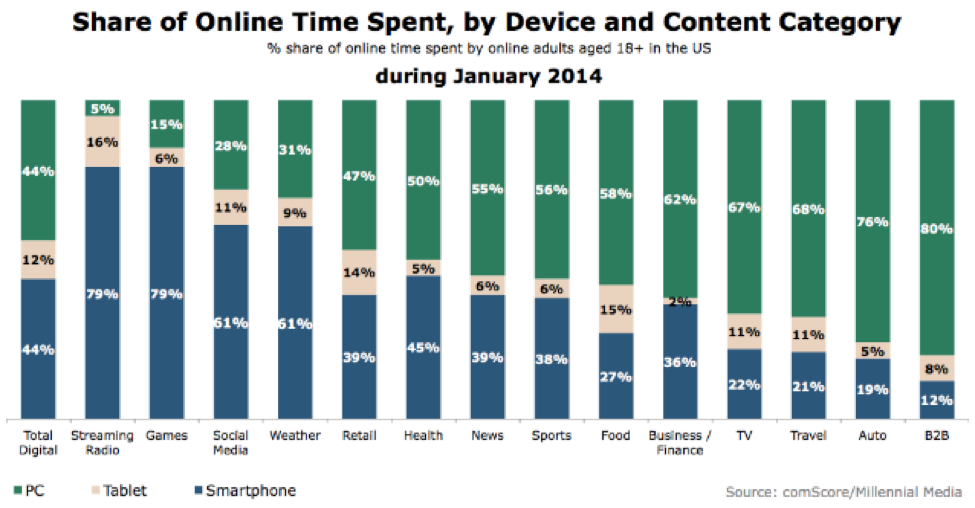
Triton Digital’s monthly Top 20 Ranker consistently places mobile listening in the high 70’s despite the fact that 80% of its twenty ranked audio publishers are legacy radio broadcasters that started building audience first on desktops and were late to transition to mobile. Pure play Internet audio streamers are more likely to have higher percentages of smartphone usage. Saavn, the biggest player today in India that also has a sizable U.S. user base is a good example. It claims more than 90% listening on mobile.
Audio is the quintessential mobile media as Pat Higbie pointed out last year. It is the one media that you can easily consume while on the go and engaged in other activities that require the use of your hands or eyes. These mobile consumers are precisely the audience that many marketers want to reach. Proximity to brick and mortar stores and to point of purchase means Internet radio is often the last potential touch point before a purchase decision. Advertising to a smartphone also enables myriad ways to engage consumers such as connecting phone calls, downloading apps and exposure to visual media such as websites and video. These features appeal to advertisers.
Mobile Advertising Numbers Are Large and Growing Fast
According to eMarketer mobile advertising in the U.S. will exceed $42 billion this year and grow to over $65 billion by 2019. In 2016, mobile will exceed desktop advertising by nearly 70% and it will be more than double in 2017.
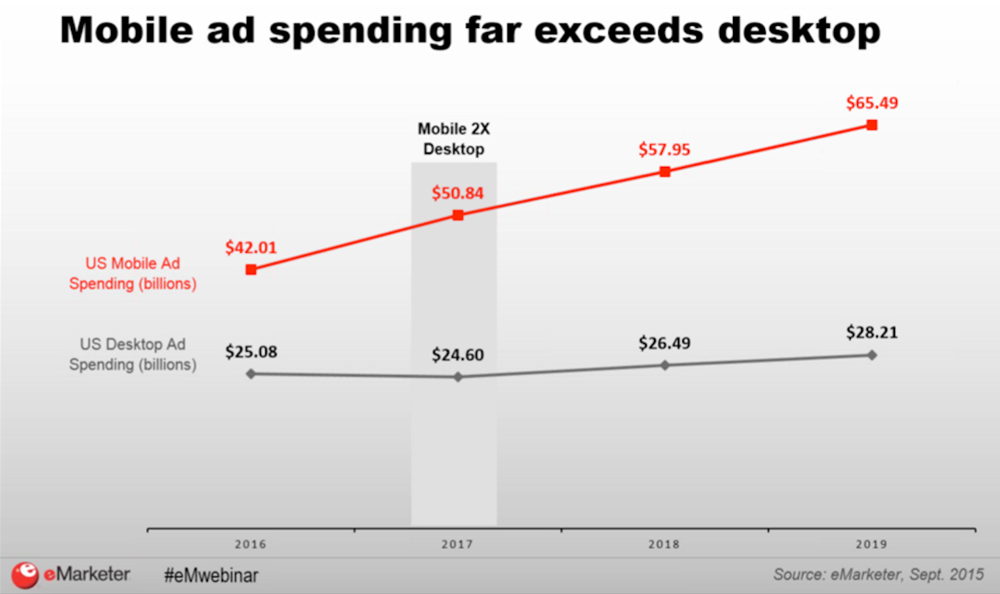
By 2020, mobile is expected to command the same ad spending share as television at 33%.
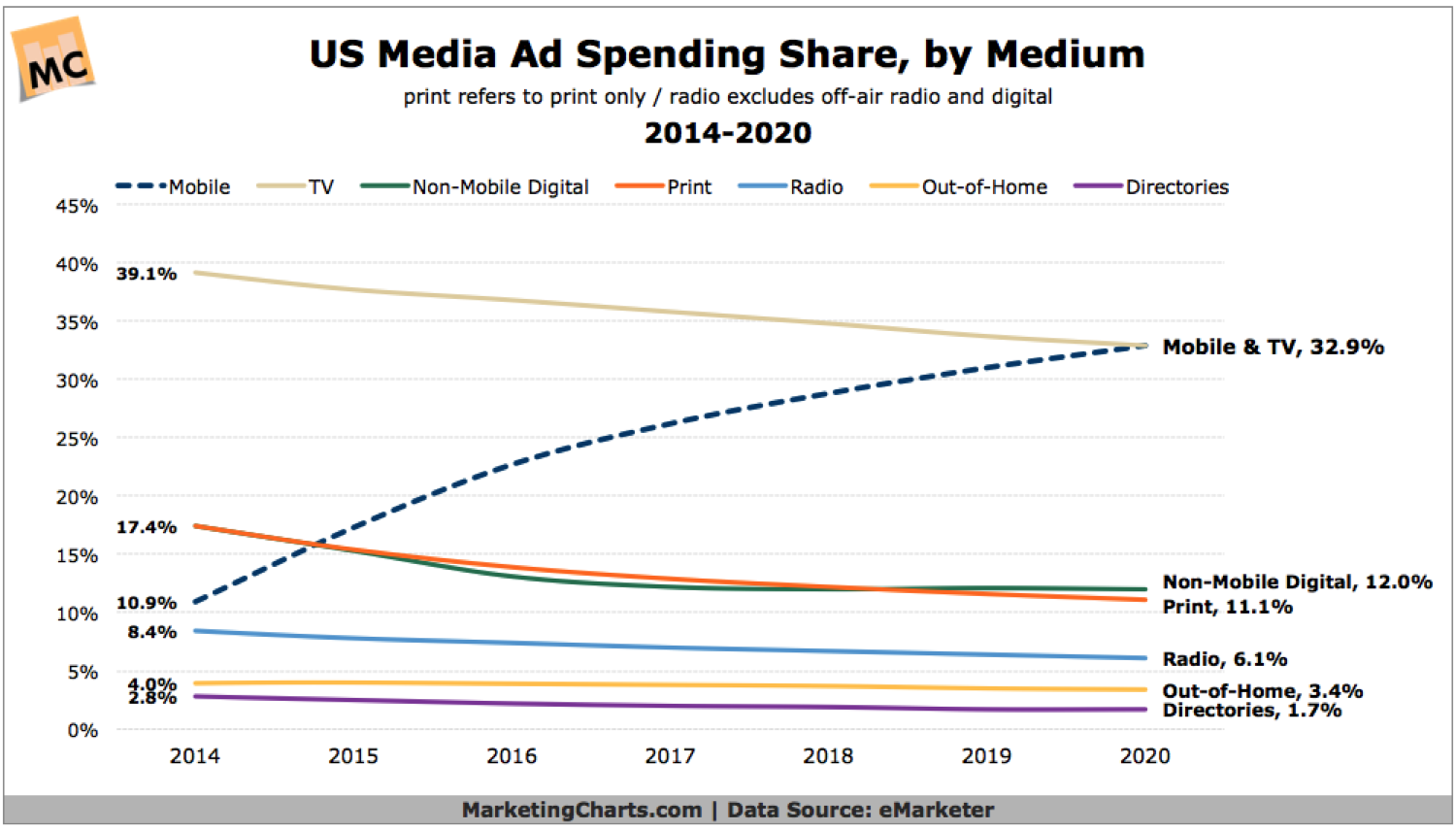
Mobile Is the Best Thing That’s Happened to Audio
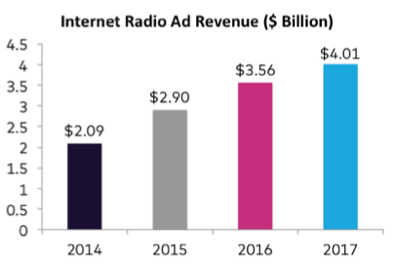 Audio in its radio manifestation was the first mass market broadcast media. However, it was eclipsed by television as the premium ad format and quickly lost advertising market share. Radio did hold its position in the advertising mix largely based on the strength of its mobile capabilities—that primarily meant the automobile. When smartphone growth took off, audio was a natural companion in a way that television couldn’t match. Now that advertising is shifting dramatically toward mobile, audio in its streaming Internet radio manifestation is in a prime position to benefit.
Audio in its radio manifestation was the first mass market broadcast media. However, it was eclipsed by television as the premium ad format and quickly lost advertising market share. Radio did hold its position in the advertising mix largely based on the strength of its mobile capabilities—that primarily meant the automobile. When smartphone growth took off, audio was a natural companion in a way that television couldn’t match. Now that advertising is shifting dramatically toward mobile, audio in its streaming Internet radio manifestation is in a prime position to benefit.
Advertising dollars follow consumers. Consumers have flocked to mobile and to ad-supported streaming Internet radio. It’s easy to understand why Internet radio advertising will exceed $3.5 billion this year in the U.S. alone.
[su_button style=”flat” size=”6″ background=”#D73C90″ radius=”0″ url=”https://go.pardot.com/emailPreference/e/35552/300″ target=”_blank”]Subscribe to XAPP Blog[/su_button]
Related Posts
What Streaming Music Subscription Numbers Reveal About Ad-Supported Listening
Edison Research: Internet Radio Weekly Listeners Hit 50% of U.S. Population
Download Internet Radio Ad Load Report Q4 2015: Advertisers Grow 5x in 2015, Ad Load Up 5.7%
